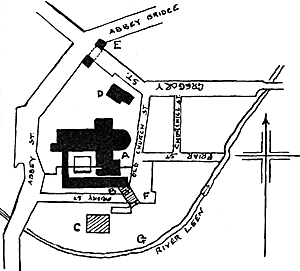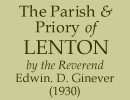< The priors of Lenton | Contents | The parish church of Lenton >
10.—THE DISSOLUTION OF LENTON PRIORY.
The events which led to the suppression of Lenton Priory may be briefly stated. Early in the year 1534, Parliament prohibited every kind of payment to the Pope and confirmed the King's title as supreme head of the English Church, vesting in him alone the right of appointing to all bishoprics and of deciding in all ecclesiastical matters. Thus the tie which for so many centuries had united England with Rome was completely severed. In November of the same year, the first-fruits and tenths were annexed to the Crown forever, and a new oath of supremacy was introduced. In the following year some of the Clergy refused, either to take the oath, or to proclaim in their churches and chapels that the Pope was anti-Christ. The system adopted with regard to them was simple and expeditious; they were condemned for high treason and hanged.
Shortly afterwards, the King, acting on the advice of Cromwell, appointed commissioners to visit the monasteries and other religious houses in England, and "to search into the lives and manners of religious persons." They were also commanded to make all the monks and nuns renounce the authority of the Pope, and to take the oath of supremacy.
In 1536, a formidable insurrection in favour of the monks broke out at Louth, in Lincolnshire, and was quickly followed by the still more formidable rising in Yorkshire, known as the "Pilgrimage of Grace." The King, enraged at the new rebellion, ordered the Duke of Norfolk to execute a large number of the insurgents in every town and village, especially among canons and monks who were blamed very much. The last Prior of Lenton, Nicholas Heyth, was one of these. Lenton Priory was one of the first monastic houses to be dissolved by Henry VIII.
Immediately on the dissolution of the monasteries, they were in most cases partially, if not completely, demolished. This general destruction was taken advantage of by the populace, who appropriated whatever materials they could lay their hands on, the result being that in many instances the grantees of monastic buildings placed persons in charge to sell the ready worked stones to the best advantage. This would probably be the case at Lenton. We have no evidence, however, of the demolition of the conventual buildings prior to 1551, but probably long before Queen Elizabeth's royal proclamation of 1560 forbidding any further instances of "churches and places spoiled, broken, and ruinated, to the offence of all noble and gentle hearts," was issued, the stately conventual church at Lenton was in ruins. Some portions of the conventual buildings however remained for some time. Assizes were held at Lenton in 1573, probably in the monastic building, owing to gaol fever in Nottingham.
Also we find from the parish register of Lenton that in 1601 some portion of the monastic building remained, for on November 26th of that year, Thomas, son of Andrew Bradforde, was baptised "qui qidem, Thas natus erat in monasterio, in domo Thsa Birche;" but Thoroton writing in the year 1672 states that, at that time, "there was only one square steeple left of the monastery, which not long since fell down."
The Priory gatehouse was, however, in existence for more than a century after Dr. Thoroton's time, and stood across Wilford Road, now called Gregory Street, near the end of Abbey Street, and was in existence at the commencement of the 19th century, part of it being occupied for parochial purposes up to the time of its demolition.
Many remains of the monastery have been dug up in Lenton at various times; carved stonework, coffins, bones (chiefly at the south end of old Church Street, which was probably therefore the site of the monastic cemetery), keys, coins, etc., and an almost complete ground plan of the monastery by William Stretton, Esq., who built a house called the Priory on the site of the Prior's Lodgings. Although the remains in situ of the Priory are so scanty, there are architectural remains scattered over the parish sufficient to indicate the character and size of the monastic buildings. For generations tooled stones have adorned the gardens of the houses in Lenton.
In building the house called Lenton Priory, now part of Nazareth House, William Stretton used many of the thousands of tiles which were dug up in the excavations, though these are not visible now. In the garden is a small graveyard, in which is a heap of tooled stones, evidently remains of the Priory, on one of which there is this remarkable inscription (though hardly readable now): "Et Verbum Caro Factum Est"—the Word was made flesh. The Priory House is now occupied by the Sisters of Nazareth, as a house of refuge for the aged, sick, and infantile poor of the neighbourhood, without reference to sex or creed.
The bases of the two pillars at the corner of Priory Street and Old Church Street are fine specimens of Norman work. Thousands of pounds have been offered for the site of these pillars. The present tenant is to be congratulated on preserving them so faithfully, on the earnest request of the late owner of the property, the Rev. Kirke Swann. It is greatly to be desired that these pillar bases should be publicly preserved.
It may here be mentioned that a local tradition exists that the porch attached to the south aisle of S. Mary's Church at Nottingham originally belonged to Lenton Priory. This is most unlikely.
In the Roman Catholic Church of Our Lady, on Lenton Boulevard, there is a font presented by Thomas Little, Esq., in memory of his wife, which is supposed to have come from Lenton Priory. This, too, is most unlikely. The supporting shaft of the font is inscribed: "This original font was used in Lenton Priory." So definite a statement must, one would suppose, have some foundation in fact. It is possibly Saxon in origin, but more probably of a much later date. It was found being used as a feeding trough at the White Hart Inn. It is exceedingly surprising that Godfrey does not mention it, and he lived at the White Hart Inn; neither does Stretton, Lowe, Stevenson, or any other local antiquary refer to it. It bears no resemblance whatever to a Norman font, nor any comparison with the genuine one in Lenton Parish Church, which is one of the finest and most perfect examples of Norman work in the country.
There was also a tradition that Wollaton Hall was partly built of remains from Lenton Priory in 1580. There is a reference in the Wollaton MSS to a payment made for 60 ell of stone supplied from the Priory. Some stone has been discovered recently in the vicinity of the lake in Wollaton Park, which was undoubtedly taken from Lenton Priory, to build a wall there.
An indenture between Edward IV and Thomas the Prior was found on the wall of the Rock Caverns in Nottingham, respecting the transfer of the Chapel of S. Mary.
Nearly 198 fodders (practically tons) of lead were taken from the roofs of Lenton Priory at the dissolution and deposited at Nottingham Castle.
At Abbey Fields there was an old house which was supposed to have been originally the grange or farmstead of the monastery.
The Arms of Lenton Priory are still to be seen at the apex of the roof of Beeston Church at the east end. In 1330, the rectory of Beeston was appropriated to Lenton Priory and it became a chapel to the mother church at Lenton. The parishioners and the poor vicar objected, but letters from Pope Alexander and Lucius III were produced, and, although these had no doubt been obtained by influence, the objection was over-ruled.
Relics of Lenton Priory, such as titles and keys, are to be seen in the Castle Museum. Had Lenton Priory been spared it would have constituted the Melrose or Fountains of our county.
 |
Plan of the Monastery Building, as approved by the late Rev. M. E. C. Waloott, F.S.A. |
Plan of the Monastery Building.
No plan of the building is available at the British Museum, the Record Office, or elsewhere. We know from other sources, as already stated, that the Priory Gateway stood across Gregory Street (E), that the present Priory Church (D) is part of the Chapel of S. Anthony, which stood in the courtyard of the monastery, and that the Priory Gardens extend southwards of the River Leen (G). Numerous human and other remains have been found at (F), and there are the bases of the two pillars in situ at the corner of the garden (B). Also we know that part of the wall dividing the garden (B) from the old churchyard formed part of the wall of the great conventual church, and that the present Nazareth House is the site of the Prior's Lodge (C), part of the foundations of which are still to be seen.
The conventual church (A) is shown with an apsidal chancel, which might have been surrounded by two or three chapels. The existing piece of wall, according to this plan, is assumed to have formed part of the wall of the south transept, and the pillars at (B) to have been part of the great calefactorium, or warming house, which would be at a tangent to the other buildings. The cloister was undoubtedly southward of the church, and the so-called Prior's Lodge was possibly a detached building, probably the Infirmary.
The remainder of the buildings are conjectural. The site of the cemetery is shown at (f), interments in the cloister garth being of the rarest occurence.
< The priors of Lenton | Contents | The parish church of Lenton >
